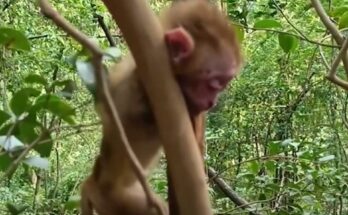Mother monkeys giving birth is a fascinating and rare event, particularly if it occurs while the mother is climbing or perched on a tree. This unique behavior highlights the resilience, adaptability, and survival instincts of these remarkable creatures. It also underscores the complexities of their lives in the wild, where balancing safety, mobility, and the demands of childbirth becomes a delicate act.
The Challenges of Arboreal Birth
Monkeys are primarily arboreal animals, spending much of their lives in trees. These environments offer protection from predators, access to food, and the ability to move swiftly. However, the tree canopy poses challenges for giving birth, a physically demanding and vulnerable process.
When a pregnant monkey gives birth while climbing, it demonstrates an extraordinary level of physical and mental strength. The process requires her to manage labor pains and contractions while maintaining her grip and balance. The need for safety is paramount, as falling from a tree during childbirth could be fatal for both the mother and her newborn.
One possible reason for giving birth in such a precarious position could be the lack of time or opportunity to find a more stable location. In the wild, predators are always a threat, and descending to the ground to give birth may expose the mother to danger. Remaining in the trees provides a natural shield, as many predators find it difficult to navigate the high canopy.
Instinctive Adaptations
Monkeys, like many other primates, rely heavily on instinct during childbirth. Their bodies are built to cope with the challenges of their environment. The mother monkey’s tail often acts as a stabilizing force, allowing her to maintain balance even during the intense moments of labor. Additionally, her strong, dexterous limbs enable her to grip branches tightly while adjusting her position.
Interestingly, monkey births are usually quick compared to humans, lasting only a few hours or even minutes. This efficiency minimizes the time spent in a vulnerable state. Once the baby is born, the mother immediately tends to it, cleaning and inspecting the newborn while ensuring it is safely attached to her body.
A Moment of Resilience and Bonding
The birth of a monkey in a tree is not just a testament to the mother’s resilience but also a critical moment for establishing the bond between mother and infant. Newborn monkeys instinctively cling to their mother, a behavior essential for survival in the arboreal world. The mother’s immediate care ensures that the baby is safe and secure, ready to adapt to its new life in the canopy.
This event also highlights the social dynamics of monkey groups. In some species, other members of the troop may provide support or act as lookouts during childbirth, reducing the risk of predation. Such cooperation emphasizes the strong social bonds within monkey communities and their role in ensuring the survival of the next generation.
Conclusion
A mother monkey giving birth while climbing a tree exemplifies the extraordinary adaptability of primates. It is a striking reminder of the resilience of wildlife and the ways in which animals overcome the challenges of their environments. This behavior underscores the delicate balance between vulnerability and strength in the animal kingdom, offering valuable insights into the lives of these intelligent and resourceful creatures.


